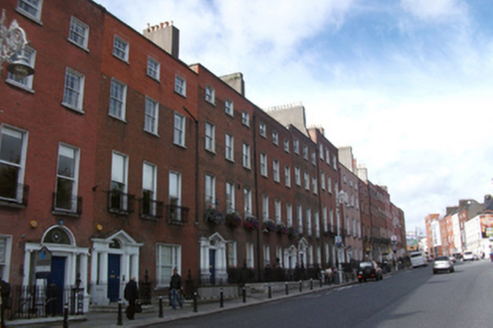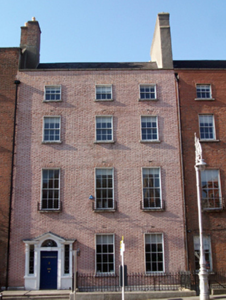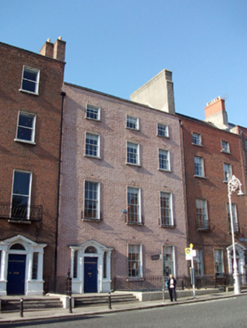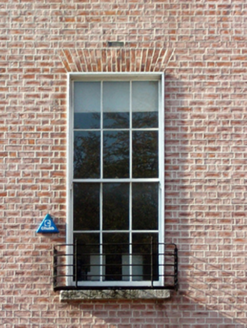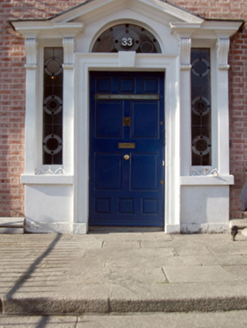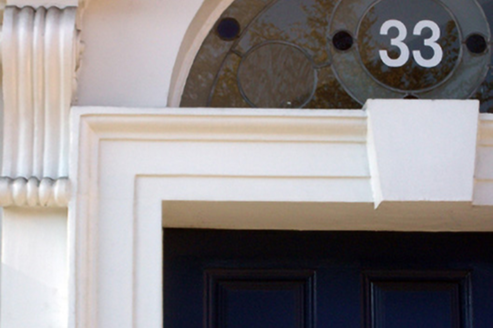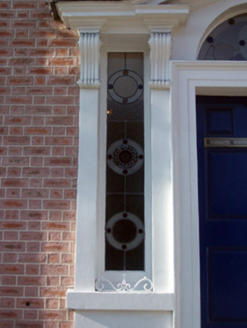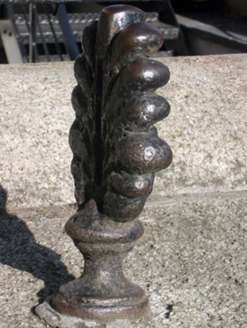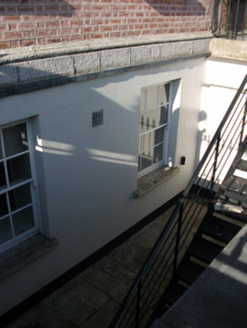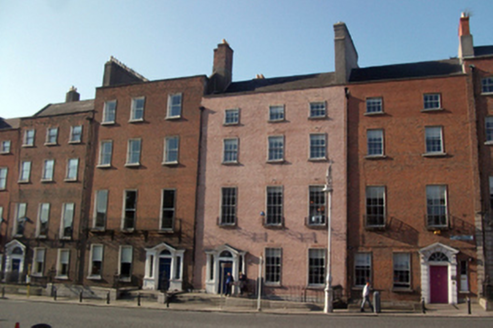Survey Data
Reg No
50010646
Rating
National
Categories of Special Interest
Architectural, Artistic
Original Use
House
In Use As
Bank/financial institution
Date
1755 - 1765
Coordinates
315547, 235055
Date Recorded
28/09/2011
Date Updated
--/--/--
Description
Terraced three-bay four-storey house over exposed basement, built c.1760. Now in use as credit union and offices. Projecting end bay to rear elevation. Pitched and hipped slate roof with clay ridge tiles hips to rear behind parapet wall with square granite ashlar coping. Full-depth rendered chimneystack to party wall and red brick and rendered chimneystacks with clay pots elsewhere. Replacement aluminium rainwater goods throughout. Flemish bond red brick walls with replacement wigged white cement pointing, moulded granite plinth course over rendered walls to basement level. Rendered walls to rear elevation. Gauged red brick flat-arched window openings with rendered reveals and granite sills. Replacement timber sliding sash windows throughout with cast-iron balconettes to first floor to front elevation. Round-headed door opening within painted Portland stone doorcase comprising moulded architrave with flat keystone, flanked by paired piers on plinth blocks, topped by scrolled corbel brackets, with cornice and open-bed pediment, housing replacement stained-glass fanlight. Replacement timber door flanked by replacement stained-glass sidelights with small cast-iron grills to sills. Door opens onto granite flagged platform with Victorian cast-iron bootscraper and granite stepped approach bridging basement area. Approach flanked by cast-iron railings on replacement granite plinths, with matching gate accessing basement via recent steel staircase. Reportedly grandest house in terrace and meant to be reduced plan of Nos. 10 and 11 with two large reception rooms and double-height entrance-cum-stair hall with service stair to rear. Open-well stair has turned and fluted banisters and Scamozzian Ionic capital to each tread. Good Rococo cartouches above dado rails. Papier-maché ceiling to ground floor front room. Fine mahogany doors to first floor, but rooms made into one in nineteenth century.
Appraisal
The largest house on the west side of historic Parnell Square, this finely-proportioned townhouse with its well-balanced façade is an integral component of the streetscape. Built by Robert Ball, along with Nos. 32, 34 and 35, it is now in use by the Irish National School Teachers Association. The retention of various historic internal and external features such as wigged pointing, balconettes, a fine tripartite corbelled doorcase and nineteenth-century replacement windows provide a refined and early aspect. The Georgian character of the house is firmly presented by the diminishing windows, tall appearance, large chimneystack, and by the well-presented foreground with plinth wall and railings to the basement area. Parnell Square was the product of Dr Bartholomew Mosse; in 1748 he leased four acres at the junction of three important sites; the Gardiner Estate, Sackville (now O’Connell) and Great Britain (now Parnell) Streets. There the New Gardens (now the Garden of Remembrance) were constructed, a landscaped tract of land with illuminated paths, obelisks and a loggia. Entrance fees to the gardens funded the construction of the Rotunda Hospital to the south, Mosse’s life ambition, and the success of the gardens precipitated the development of the surrounding square, largely by the hospital’s chief builders. The house also contains good plasterwork to the interior.
